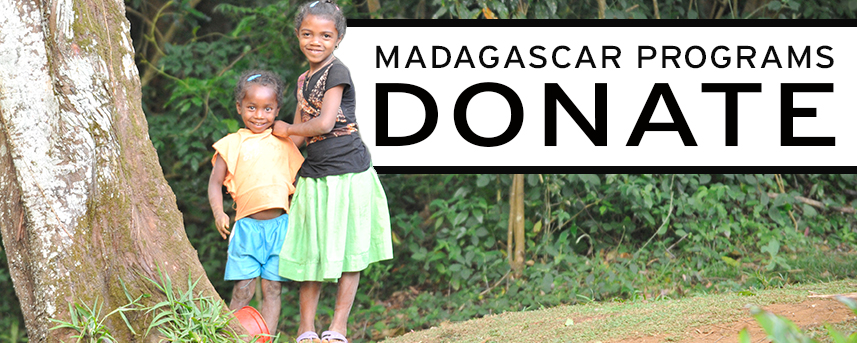Evrard Benasoavina (1, 2) , Anicet Elcar Ranaivoson (3), Ardhilles Andriantinefiarijaona (3)
1 DLC-SAVA Conservation
2 New Generation School Garden
3 Regional University of SAVA / DLC Consortium
Earth Day may only come once per year, but at DLC-SAVA Conservation, we have been celebrating Earth Day since March and will continue until May! We are working hard to motivate communities around the SAVA region to participate in conservation activities. We had four recent events to promote nature conservation and sustainable resource management, engaging almost 1000 people in activities including reforestation, agroecology, and environmental education. We plan to continue all year long because we should celebrate nature every day!
Reforestation at New Generation School Garden
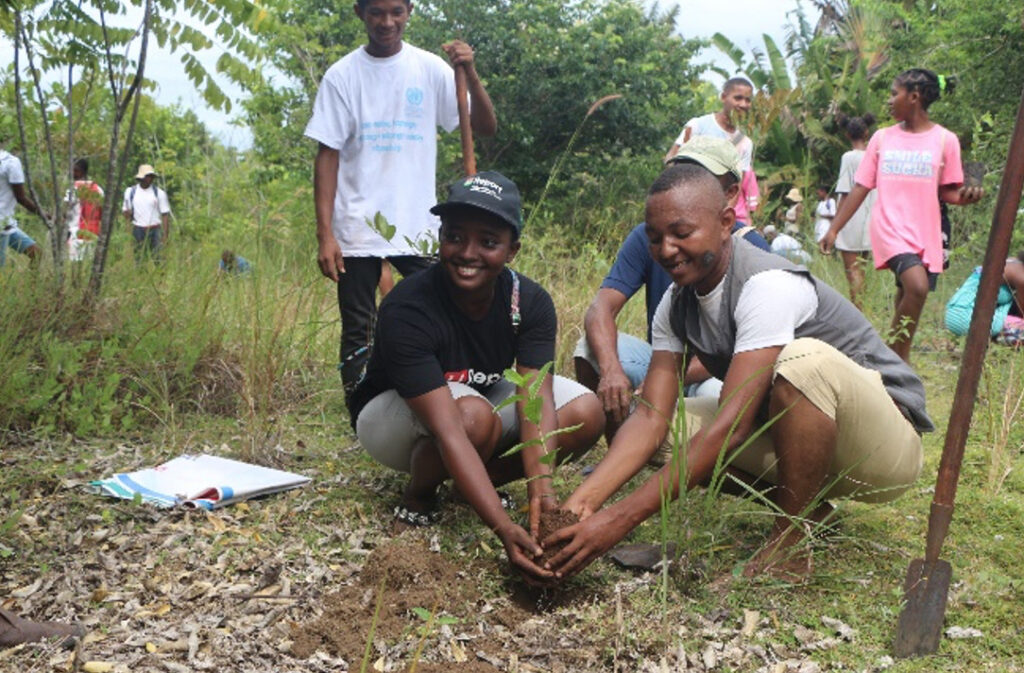
In Sambava on March 25, we celebrated the annual Day for Youth, the Journées de Jeunesse. The leader of the local youth group (Parlement des Jeunes SAVA) contacted us (Evrard of New Generation School Garden and DLC) because they wanted their association to plant fruit trees, demonstrating the motivation of Sambava’s youths to restore the environment. They chose to come to New Generation because they heard about all the environmental education activities we’re doing there and they know that it is a safe place for young people to come experience nature and where the planted trees will be cared for and maintained in the long-term. They brought over 2,000 seedlings of mango, guava, tamarind, soursop, jackfruit, and custard apple. Almost 600 young people came to plant the seedlings, including 19 associations like sports clubs like football teams, private schools, and other groups. While visiting the garden, they also saw the different species of trees I plant on my agroforestry farm, the classroom I built to teach children about the environment, and the garden where I grow diverse vegetables and beans. Everyone agreed that this is a unique place in the SAVA where people can come to experience nature and learn how to do the same on their own land.

Almost 600 young people came to the New Generation School Garden to plant 1,000 trees!
The groups made speeches about why they felt it was important to plant trees for generations to come. During the speeches, a big boa constrictor slithered through the crowd and while many people were afraid, I explained why this snake is important for nature: they eat pests like rats, as predators, they are an integral part of the ecosystem, and the goal of the New Generation School Garden is to protect biodiversity. Everyone who came was satisfied and said they want to return and do more at the school garden. We welcome all the people who want to come to our school garden for a visit!
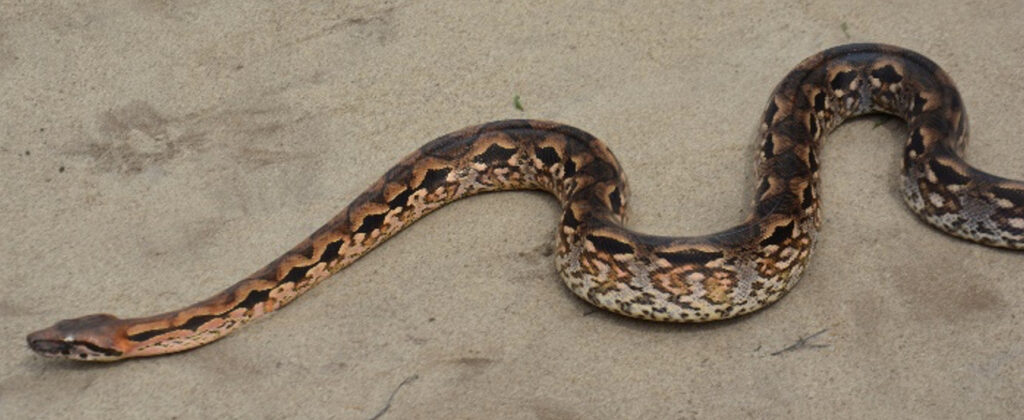
Everyone is welcome at NGSG, including boas!
Reforestation at the sacred mountain of Ambanitaza
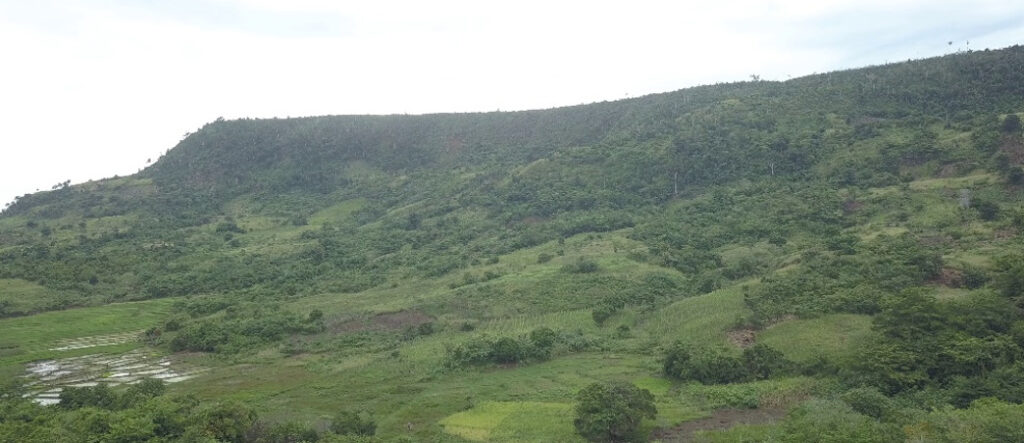
The sacred mountain of Ambanitaza is located near Antalaha. While forested until the early 2000s, the exploitation of wood and fires from charcoal production have fragmented the remaining forest, where lemurs can still be found.
As part of our long-term reforestation goals, we are collaborating with a local community-based conservation organization that is protecting and restoring a sacred mountain called Ambanitaza. In the early 2000s, this mountain was still forested, but as people harvested trees for building materials and making charcoal, there have been many fires and deforestation that have left most of the mountain bare. Our mission since 2020 has been to assist the local association to protect the remaining forests, and the sacred waterfall at which local people hold traditional rituals, asking God and the spirits of their ancestors to give them good luck, heal their sick, and bring them prosperity.
Led by Anicet, during the month of April, we have been working with the local community to plant over 17,000 trees on the mountain to restore the forest that was lost. In September 2021, we started a tree nursery on the mountain to grow seedlings that we can plant. Over 12,000 native trees were grown, and we obtained another 2,000 from the local Graine de Vie nursery, who provides seedlings for free to all people who want to plant them.
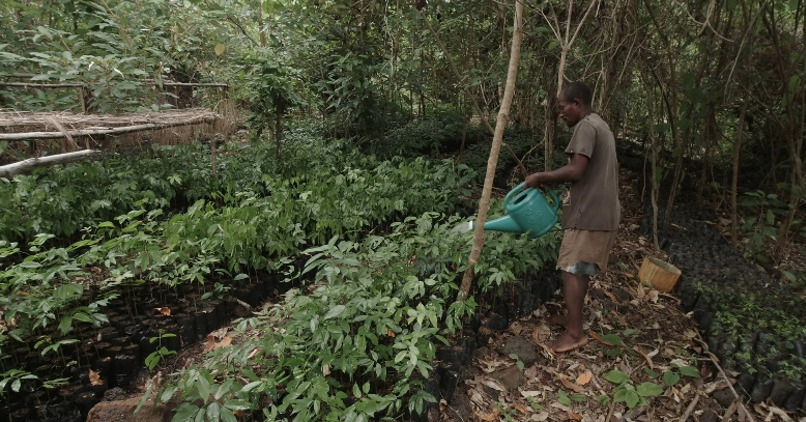
Over 12,000 seedlings of native trees were grown in our tree nursery, supplemented with seedings from Graine de Vie and direct seeding.
We are also experimenting with direct seeding using ‘seed balls,’ a method that works well in east Africa, but has yet to be employed in the SAVA region. All it requires is tree seeds and mud! We employed local women to pack quality soil and compost into fist-sized balls. In each ball, we place 1-2 seeds, then planted them in between the tree seedlings. This ensures that even when tree seedlings die (~50% of seedlings survive the first year based on our research), new seedlings are growing to replace them.
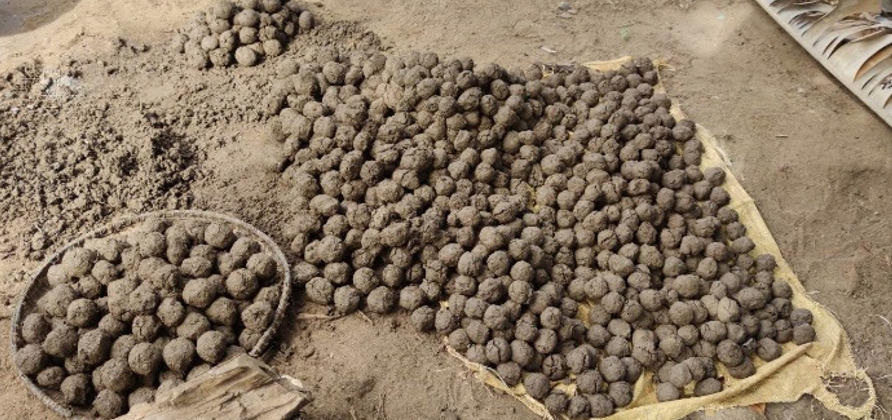
In addition to 14,000 tree seedlings, we made 1,500 seed balls, a mix of quality soil and compost with 1-2 tree seeds in each. While this method is common in other settings, it is our first time trying it in SAVA and we’re excited to see the results.
Over 50 people came to plant the trees and seed balls, all committed to protecting this mountain for generations to come. They know that protecting the mountain forest means protecting the source of the water on which they depend. This is the main reason we are working so hard; people are already experiencing the effects of climate change and the water sources are going dry. By reforesting the watershed, we are protecting biodiversity and the headwaters of the streams that feed bigger rivers, which lead to the villages where people collect water for cooking, drinking, and irrigating their rice fields. Without this mountain forest, people would have no water and that is why we are committed to restoring Ambanitaza.
Training the next generation of scientists and natural resource managers
Hands-on learning
At the regional university in the SAVA region, called CURSA, we have two departments specifically focused on agronomy and natural resource management. Students from CURSA are not only studying in the classroom, but they are practicing what they learned in the field. We are also teaching farmers how to use agroecology techniques to improve their yield, heal their soils, and restore their landscapes. Through multiple initiatives, we are both teaching new methods as well as bringing back traditional techniques that mimic nature in agriculture and safeguard both biodiversity and food security.
The students at CURSA engage in multiple hands-on practical experiences to learn about sustainable and regenerative agriculture as well as improve their yields through crop diversification and amending soils. First, we train students in diverse agricultural techniques through workshops, field trips, and practicums. Then, when students have gained the necessary skills, they become teachers, extending the skills learned at university to farmers in the countryside.
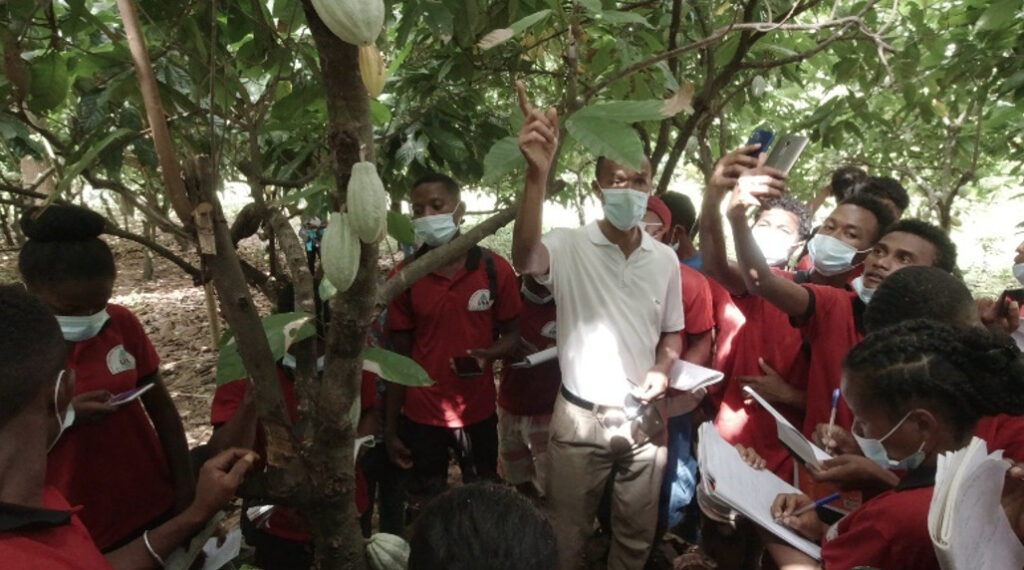
Over 200 students from the regional university are engaged in field trips to visit local leaders in agroforestry, like Michele Besinoa who demonstrates his diverse farm including high-quality cacao.
For example, students at CURSA participate in field trips to visit local leaders in agroecology, including the diversified agroforestry of Michel Besinoa, who grows cloves, cacao (chocolate), and diverse food crops. Michel teaches about the importance of soil health for all crops, and is also an ardent student, always seeking to learn new techniques such as grafting, cloning, and other methods to propagate the best, drought- and pest-resistant varietals. CURSA students also recently visited Soavoanio, the largest coconut producer in the SAVA region. Coconuts are one of the most famous crops of the SAVA region; SAVA coconuts are highly sought-after in all other regions of Madagascar, and coconuts are second only to the other prized cash-crop of the region: vanilla. After learning about the complexities of high-quality coconut production and how hybrid varietals may provide both drought-resistance and the prized taste of SAVA coconuts, the students visited the New Generation School Garden. Spread across 3 different visits, over 200 students were engaged in these educational field trips.
Learning by teaching
Once students gain experience through coursework, field trips, and independent research, graduates have opportunities for post-grad internships. Through the CURSA-DLC consortium, interns become teachers, spreading their gained knowledge back to the communities from which they came. Many CURSA students grew up in the rural countryside, so for them to return to their home villages and share their experiences is an honor and a responsibility.
Led by Ardhilles, the CURSA Agroecology interns recently returned from a mission to Vohemar, the northern district of the SAVA region. Until now, DLC-SAVA Conservation has had relatively few programs in Vohemar, but through the CURSA-DLC collaboration, we are now reaching communities in the farthest reaches of the SAVA. Vohemar is characteristically drier than other regions of SAVA, making agriculture more difficult. Nevertheless, most of the people in Vohemar are farmers, and in April, we led an agroecology workshop that reached 70 farmers. Focusing on climate-smart approaches to crop-rotation and rainwater harvesting techniques, this workshop was the first step towards enhancing water-capture in drylands for the CURSA-DLC collaboration.

70 participants in Vohemar practiced agroecology methods to create amended garden beds with water-capture techniques to maximize the minimal rainfall in this drought-prone district of SAVA.
The 70 participants were separated into two groups: 35 men worked together with 4 male trainers, and 35 women with 4 women trainers. Gender disparities often limit the participation of women in such workshops, and that is why we devised this system of gender-focused training. Further, women are often restricted with household chores, but by creating diverse home vegetable gardens, they are able to increase household production while also maintaining the fundamental needs at home. During the week-long workshop, participants learned and practiced foundational skills in agroecology, including making compost, amending degraded soils with enriched organic matter, and implementing polyculture to grow diverse and nutrient-dense crops even in a small space (~2m2 or <22 ft2). All participants were extremely grateful for the workshop, and they attested that it was the first time they ever had such hands-on skills development training. They all guaranteed that they will employ the skills they learned in the workshop in their own home gardens and agricultural fields, and we will follow up with them next month, and every month thereafter, to help them realize their goals.
Conclusion
In the SAVA region, we celebrate Earth Day every day of the year because most of us depend on the environment for our everyday needs. Without a healthy environment, we would have no water to drink, no food to eat, and no shelter under which to sleep. Without the forest, there would be no firewood to cook our meals, no streams to feed our rivers, and no predators to reduce our pests. That is why we know we must restore the landscape, protect the remaining forest, and educate our youth about conservation. We will continue this mission every day to realize our goals. Unless we act now, there will be no resources for our children or our grandchildren to live happy, healthy lives. We owe it to our future generations to bring back the natural resources previous generations enjoyed. It is hard work, but we are ready for it, and we can complete it! Vitako izany!
Fisaorana – Thanks & Acknowledgements
None of these activities would be possible without the generous support of our community, from the youth groups who donate their time and their hard work, to the donors abroad who financially support our efforts. We are especially grateful for the support of the McQuade Foundation, General Mills, Re:wild, GEO, generous gifts from the Cooke and Knox families, and hundreds of other loyal donors. We could not accomplish our goals without your help, and we owe you a huge debt! We will pay it back with the trees we grow, the species we protect, and the youth we teach. Our efforts in Madagascar do not only safeguard our own livelihoods, but mitigate climate change globally, protect world-renowned and cherished biodiversity, and address humanitarian issues seen around the world. We thank you all so much for your contributions and we wish you a happy and healthy Earth Day!

